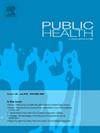Stroke incidence, trends, and geographic disparities in Ghana: An analysis of nationwide health facility records
IF 3.9
3区 医学
Q1 PUBLIC, ENVIRONMENTAL & OCCUPATIONAL HEALTH
引用次数: 0
Abstract
Objectives
Despite the increasing burden of stroke and its effects in sub-Saharan Africa, there is a paucity of empirical studies on the burden of stroke and its risk factors to help guide targeted interventions in the region. This study examines the incidence, trends and some factors associated with stroke cases in Ghana.
Study design
Retrospective analysis of observational routinely collected data.
Methods
Empirical data of confirmed stroke cases from all government-affiliated healthcare facilities were extracted from the District Health Information Management Systems of the Ghana Health Service spanning 2016–2021. Variables include stroke case counts by sex, age group and location. Cartographic geospatial mapping of stroke case density and negative binomial regressions were employed to assess trends and factors associated with stroke.
Results
Stroke cases increased by more than two-fold in just six years (from 10,732 to 23,009). The rates for people 35–59years (IRR = 5.06, 95% CI: 4.04–6.63) and those above 60 years (IRR = 6.29, 95% CI: 5.01–7.88) were 5 and 6 times higher compared with 0–35year old. The rate of stroke in the year 2021 was 61 % higher than in 2016 (IRR = 1.61, 95% CI: 1.18–2.21). People in the northern savannah ecological zone had 77 % lower rate of stroke compared with those in the coastal zone of Ghana (IRR = 0.23, 95% CI: 0.18–0.30).
Conclusions
The incidence of stroke in Ghana is rising across all age groups, sexes and locations with a trajectory of early onset within the life course. There is an urgent need for the implementation of public health interventions for early detection, prevention and management of stroke cases in the country.
求助全文
约1分钟内获得全文
求助全文
来源期刊

Public Health
医学-公共卫生、环境卫生与职业卫生
CiteScore
7.60
自引率
0.00%
发文量
280
审稿时长
37 days
期刊介绍:
Public Health is an international, multidisciplinary peer-reviewed journal. It publishes original papers, reviews and short reports on all aspects of the science, philosophy, and practice of public health.
 求助内容:
求助内容: 应助结果提醒方式:
应助结果提醒方式:


